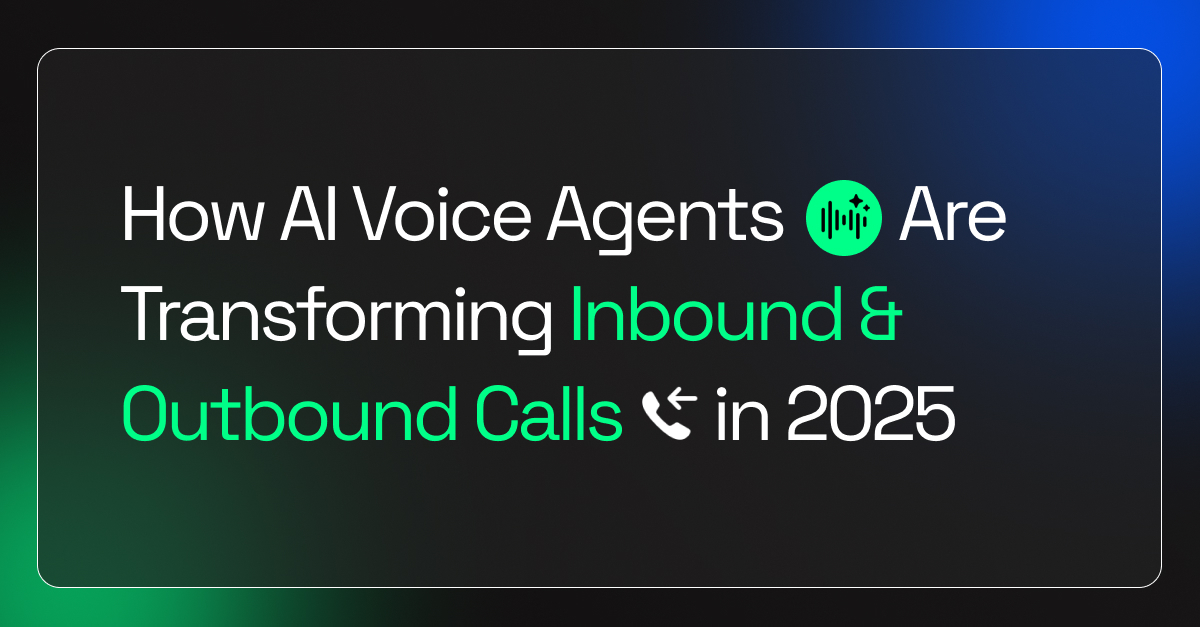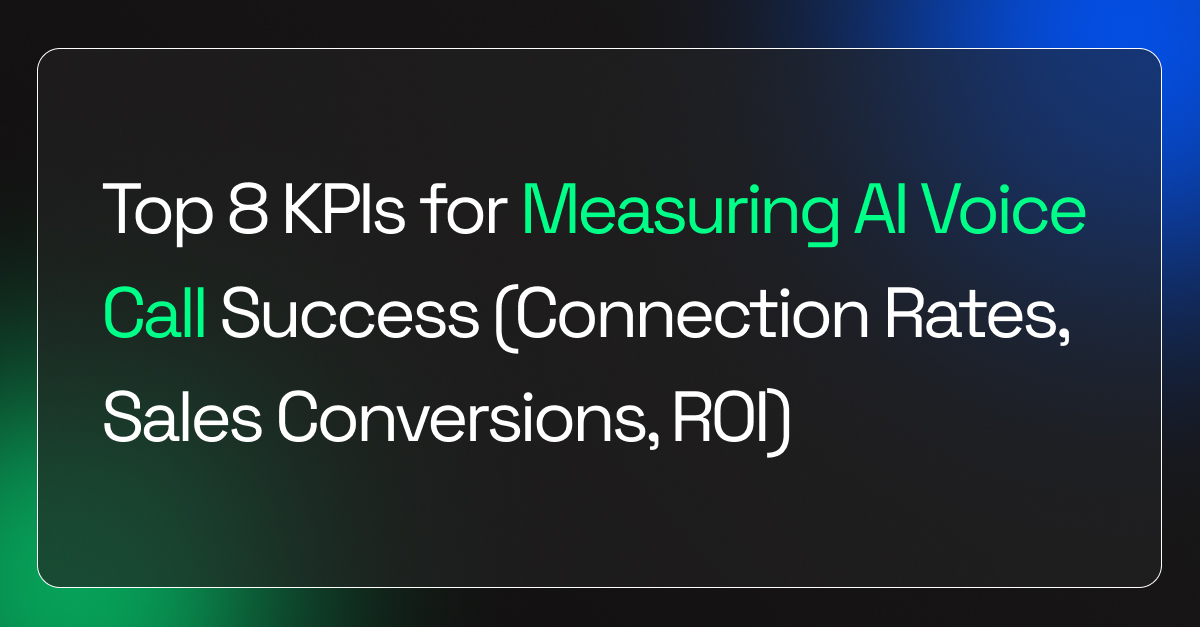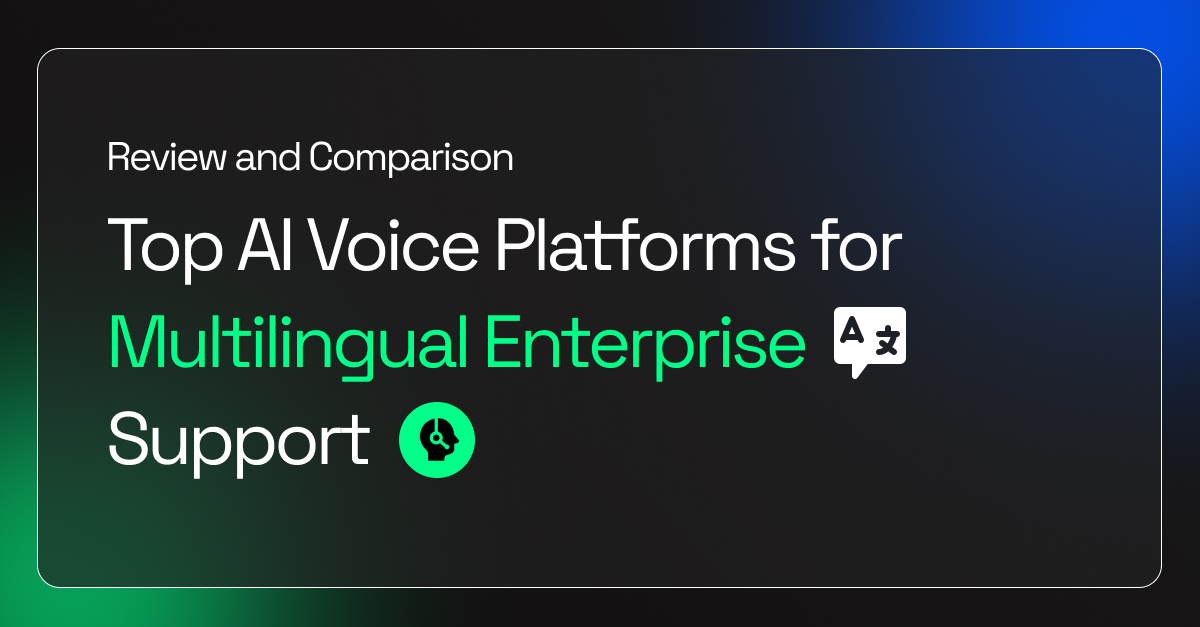When it comes to customer conversations, timing is everything. A qualified lead sitting in your CRM hours late? That’s already a lost opportunity. A support ticket created after the customer has already churned? Too little, too late.
That’s where AI phone agents change the game—handling calls at scale, capturing intent, and making conversations smarter.
But here’s the catch: if the data from those calls doesn’t flow instantly into your business systems, the magic falls flat.
Enter webhooks—the real-time messengers that keep your sales, support, and analytics tools in sync the second a call ends. Think of them as the express delivery guys for your call data—no delays, no manual updates, no “I’ll check later.” Just instant automation that makes your workflows faster, smarter, and reliable.
In this blog, we’ll break down how webhooks supercharge AI phone agents, why real-time call data is a must-have, and how you can plug VoiceGenie into your CRM, ERP, or analytics stack for seamless sync.
What Are Webhooks and Why They Matter in AI Phone Agents
At its core, a webhook is a way for one system to talk to another instantly—no polling, no delays. Instead of your CRM or ERP repeatedly asking “any new calls?”, a webhook pushes the data the moment an event happens.
It’s like having a smart assistant that shouts updates straight to your team the second something important happens.
For AI phone agents, this means every call detail—call logs, transcripts, and lead status—can flow directly into your business systems in real time.
Unlike traditional APIs where your system fetches data on a schedule, webhooks ensure that your CRM, ERP, or analytics dashboards are always fresh and actionable.
What Are Webhooks and Why They Matter in AI Phone Agents
Let’s cut through the jargon: webhooks are like instant messengers for your apps. Instead of asking your CRM every few minutes, “Hey, any new calls?”—webhooks just push the info the second an event happens.
For AI phone agents, this is a game-changer. Every call generates valuable data—call duration, outcome, sentiment, transcript, and even lead scoring.
But this gold is useless if it’s stuck in the agent platform waiting for someone to manually export it.
Here’s why webhooks matter:
- Push, don’t pull: APIs are great, but they’re request-based. Webhooks are event-based—data goes where it needs to go instantly.
- Real-time insights: Your dashboards, CRMs, and ERPs get updates as the action happens, not hours later.
- Automation-friendly: With webhooks, every call can trigger follow-ups, notifications, or workflow actions automatically—no human in the loop required.
In short, webhooks bridge the gap between AI agents and enterprise systems, making your operations faster, smarter, and hands-off.
The Role of Real-Time Call Data in Business Workflows
Data is only as good as the speed at which it moves. Imagine this: an AI phone agent qualifies a lead in the morning, but your sales rep doesn’t see it until afternoon.
By then, the lead has already cooled off, and your competitor swoops in.
Real-time call data solves this problem. Here’s how it impacts business workflows:
- Sales acceleration: Immediate lead updates in your CRM let reps follow up while the conversation is still fresh.
- Support efficiency: Customer issues are logged automatically, reducing response times and improving satisfaction.
- Analytics & reporting: Live dashboards track agent performance, call trends, and customer sentiment as they happen, not in delayed batches.
- Operational consistency: Orders, payments, and confirmations update enterprise systems instantly, reducing errors and manual interventions.
Without real-time sync, your workflows face bottlenecks, delayed actions, and missed opportunities.
With VoiceGenie + webhooks, your AI agents become more than just call handlers—they drive the business in real time.
How Webhooks Enable Call Sync Automation?
Here’s where the magic happens. Webhooks turn your AI phone agents from voice-only tools into real-time workflow engines.
Instead of waiting for someone to manually move data between systems, every call event can instantly trigger actions across your CRM, ERP, or analytics stack. Let’s break down the flow:
Step-by-Step Flow
- Customer interacts with the AI phone agent
- A lead calls in, asks questions, or even completes a transaction.
- VoiceGenie captures every detail call time, duration, transcript, sentiment, and lead info.
- Call event triggers a webhook
- VoiceGenie immediately fires a webhook to the configured endpoint.
- Think of it as your AI agent saying, “Hey, something just happened—here’s the info!”
- Data pushed to enterprise systems
- The webhook payload (JSON or XML) hits your CRM, ERP, or analytics tool.
- Example actions:
- CRM: Create or update a lead, log call details, update deal stage.
- ERP: Update order status, payment confirmations, or inventory changes.
- Analytics: Update dashboards in real time, track KPIs, or trigger alerts.
- Systems respond automatically
- Your tools don’t just sit there—they take action:
- The sales rep gets an instant notification for follow-up.
- Support tickets are auto-created for unresolved issues.
- Marketing automation triggers next-step emails or SMS.
- Your tools don’t just sit there—they take action:
- Reliability and monitoring
- VoiceGenie ensures webhooks are delivered reliably.
- Failed deliveries can retry automatically, and logs help track any issues.
Why This Matters
- Zero delays: No more waiting for batch updates or manual entry. Every call counts the moment it happens.
- Hands-off automation: Teams focus on strategy and relationships, not tedious data entry.
- Seamless scaling: Whether it’s 10 calls or 10,000, webhooks keep everything flowing smoothly.
Key Integrations for Enterprises
AI phone agents are powerful on their own, but the real value emerges when they talk to your existing enterprise tools seamlessly. Webhooks are the bridge that connects VoiceGenie to the systems your teams already rely on, enabling real-time call data sync across the organization.
CRM Integrations
- Salesforce, HubSpot, Zoho: Automatically update leads, contacts, and deal stages as soon as a call ends.
- Sales reps receive instant notifications for follow-up, ensuring no lead goes cold.
- Example: A lead qualifies through VoiceGenie → webhook pushes the info → Salesforce updates deal status → rep gets a real-time alert.
ERP Integrations
- SAP, NetSuite, Oracle ERP: Sync order confirmations, payment details, or inventory updates automatically.
- Eliminates manual data entry errors and keeps operations running smoothly.
- Example: Payment confirmation call → webhook updates ERP → finance team reconciles instantly.
Analytics & Business Intelligence
- Tableau, Power BI, Looker: Track agent performance, call trends, and customer sentiment in real time.
- Live dashboards help managers make data-driven decisions without delays.
- Example: AI agents handle 500 calls → dashboards update automatically → trends detected immediately.
Support & Ticketing Systems
- Zendesk, Freshdesk, ServiceNow: Automatically create tickets or update existing cases after a call.
- Reduces response time and ensures customer issues are addressed instantly.
- Example: Customer reports a problem → webhook creates a Zendesk ticket → support team receives instant notification.
By leveraging VoiceGenie webhooks, enterprises achieve a single source of truth for all call-related data, ensuring operations are faster, smarter, and more reliable.
Technical Setup: Implementing Webhooks with VoiceGenie
Setting up webhooks with VoiceGenie is straightforward yet powerful, enabling real-time automation without heavy coding. Here’s a step-by-step guide:
Step 1: Enable Webhook in VoiceGenie Dashboard
- Navigate to the VoiceGenie dashboard → Integrations → Webhooks.
- Toggle to enable webhook events.
Step 2: Configure Endpoint URL
- Add the endpoint of your system (CRM, ERP, analytics platform) that will receive the webhook payload.
- Ensure it supports HTTPS for security.
Step 3: Define Events to Track
- Choose the events you want to trigger a webhook:
- Call completed
- Lead qualified
- Payment confirmed
- Missed call or voicemail
- Only track events that matter to avoid unnecessary load on your systems.
Step 4: Test With Sample Payload
- VoiceGenie provides a sample JSON payload for testing.
- Example snippet:
{
“call_id”: “VG12345”,
“caller_number”: “+1234567890”,
“status”: “completed”,
“duration_seconds”: 180,
“lead_status”: “qualified”,
“transcript”: “Customer asked about product pricing…”
}
- Send this payload to your endpoint to ensure your system parses it correctly.
Step 5: Monitor and Maintain
- Check logs to confirm all events are delivered successfully.
- Configure retries for failed webhook calls.
- Ensure endpoints can handle large volumes if call traffic spikes.
By following these steps, VoiceGenie webhooks connect your AI phone agent to enterprise systems in minutes, making real-time call data available for immediate action.
Best Practices for Webhook Reliability
Webhooks are powerful, but their value depends on how reliably they deliver data. Even the fastest AI phone agent is only as good as the system receiving its events. To ensure your real-time call data sync runs smoothly and without hiccups, follow these best practices:
1. Secure Your Endpoints
- Always use HTTPS endpoints to encrypt data in transit.
- Implement authentication (API keys, tokens, or HMAC signatures) to prevent unauthorized calls.
- Restrict incoming requests to known IPs or domains to add an extra layer of security.
2. Handle Failures Gracefully
- Webhooks can occasionally fail due to network issues or system downtime.
- Implement automatic retries with exponential backoff to avoid overloading the receiving system.
- Log all failed attempts and alert your team for manual inspection if needed.
3. Validate Payloads
- Always validate incoming payloads to ensure your system only processes legitimate events.
- Check for missing fields, invalid data types, or duplicate events.
- This prevents errors from propagating into your CRM, ERP, or analytics tools.
4. Monitor and Log Events
- Maintain a centralized log of all webhook deliveries, including timestamps, payload, and response status.
- Use these logs to troubleshoot issues and optimize your webhook strategy over time.
- Dashboards can help track success rates, latency, and any recurring failures.
5. Optimize Event Selection
- Only send events that matter—too many unnecessary calls can overwhelm your systems.
- Example: Track “call completed” or “lead qualified” rather than every single interaction in verbose detail.
- Focused events reduce noise and improve the speed of actionable workflows.
6. Test Before Scaling
- Always run a pilot test with a small volume of calls before going enterprise-wide.
- Validate the entire workflow: AI agent → webhook → CRM/ERP/analytics → automated action.
- Ensure your infrastructure can handle spikes in call volume without missing events.
Why These Practices Matter
Following these best practices ensures that real-time call data doesn’t just arrive—it arrives reliably, securely, and in a usable format. With proper setup, VoiceGenie webhooks become a trustworthy backbone for your automated workflows, helping enterprises stay agile and responsive.
Real-World Use Cases
Webhooks transform AI phone agents from simple call-handling tools into real-time workflow engines. By automatically pushing call data into enterprise systems, businesses can save time, reduce errors, and act instantly on customer interactions. Here’s how it plays out in real-world scenarios:
1. Sales Acceleration
- Scenario: A lead calls your sales line to inquire about a product.
- Webhook in action: VoiceGenie captures the call, scores the lead, and triggers a webhook to Salesforce or HubSpot.
- Impact: The sales rep gets an immediate notification, lead details are updated, and follow-ups happen while the lead is still warm.
- Result: Shorter response times, higher conversion rates, and a more efficient sales pipeline.
2. Automated Customer Support
- Scenario: A customer reports an issue or requests assistance.
- Webhook in action: VoiceGenie logs the call, generates a transcript, and triggers a webhook to Zendesk or Freshdesk.
- Impact: A ticket is created automatically, and the support team is notified instantly.
- Result: Faster resolution, higher customer satisfaction, and reduced manual data entry for support teams.
3. Financial & Compliance Workflows
- Scenario: Customers call to confirm payments, subscriptions, or account updates.
- Webhook in action: VoiceGenie pushes call outcomes to ERP systems like SAP or NetSuite.
- Impact: Finance teams can reconcile payments in real time, trigger automated workflows for approvals, and maintain accurate audit trails.
- Result: Reduced human errors, compliance-ready records, and streamlined financial operations.
4. Marketing & Analytics Automation
- Scenario: AI phone agents run campaigns or collect feedback via calls.
- Webhook in action: Call metadata and transcripts are sent to analytics platforms like Tableau or Power BI.
- Impact: Real-time dashboards track agent performance, campaign effectiveness, and customer sentiment.
- Result: Marketing decisions can be data-driven and proactive, rather than reactive.
5. Multi-System Orchestration
- Scenario: Large enterprises often use multiple systems—CRM, ERP, helpdesk, and analytics platforms simultaneously.
- Webhook in action: VoiceGenie sends the same call event to multiple endpoints simultaneously, ensuring all systems are updated in sync.
- Impact: No silos, seamless workflows, and a single source of truth for all customer interactions.
- Result: Operational efficiency, reduced data discrepancies, and actionable insights available instantly.
Key Takeaway: With webhooks, AI phone agents like VoiceGenie don’t just take calls—they drive business actions in real time, enabling enterprises to act faster, smarter, and more efficiently.
Future Outlook: Webhooks + AI Agents = Autonomous Workflows
The combination of AI phone agents and webhooks is just the beginning. As enterprises evolve, real-time call data will power fully autonomous business workflows, making manual intervention increasingly obsolete. Here’s what the future looks like:
1. End-to-End Automation
- Current state: AI agents handle calls and webhooks update CRMs, ERPs, or analytics dashboards.
- Future state: Every call event triggers a series of automated actions across multiple systems—sales follow-ups, support tickets, inventory updates, financial reconciliation, and marketing triggers—without any human touch.
- Impact: Companies move from reactive operations to proactive, automated decision-making.
2. Event-Driven Architectures
- Webhooks are the backbone of event-driven systems, where every business event triggers immediate action.
- Enterprises can adopt serverless architectures (like AWS Lambda or Google Cloud Functions) to handle webhook events dynamically, scaling automatically with call volume.
- Benefit: No bottlenecks during spikes in call traffic; workflows remain smooth and reliable.
3. Smarter AI Decisions
- With real-time data flowing seamlessly, AI agents can learn and optimize their interactions continuously.
- Example: If a customer frequently requests a specific service, the AI agent can adjust call routing, messaging, or upsell offers in real time.
- Outcome: AI phone agents become not just reactive assistants, but intelligent business enablers.
4. Integration with Advanced Analytics & Predictive Tools
- Real-time call data can feed predictive models to anticipate customer behavior, forecast sales, or detect churn.
- Enterprises can leverage machine learning pipelines connected via webhooks for smarter business insights.
- Result: Decisions are faster, more accurate, and backed by live operational data.
5. The Competitive Edge
- Companies that adopt webhook-driven AI agents gain speed, agility, and insight over competitors relying on delayed data updates.
- Real-time call sync isn’t just a convenience—it’s a strategic advantage in fast-moving markets.
Key Takeaway: The future of enterprise communication isn’t just AI answering calls—it’s AI driving complete, automated workflows. Webhooks make this possible, turning VoiceGenie from a voice assistant into a real-time business accelerator
Conclusion
In today’s fast-paced business environment, speed, accuracy, and automation define success. AI phone agents like VoiceGenie are already transforming customer interactions, but their true potential is unlocked when real-time call data flows seamlessly into enterprise systems.
Webhooks act as the bridge that makes this possible. They ensure that every call—whether a lead qualification, support ticket, or payment confirmation—is pushed instantly to CRMs, ERPs, analytics tools, and more. This real-time synchronization:
- Eliminates manual data entry and human errors.
- Accelerates sales and support workflows.
- Provides actionable insights for decision-makers.
- Enables enterprise-scale automation without additional overhead.
With webhooks, your AI phone agents aren’t just taking calls—they’re driving business outcomes. Enterprises that leverage this integration gain a strategic advantage, acting faster, smarter, and more efficiently than competitors stuck with delayed data.
Take the next step: Integrate VoiceGenie with your systems today and turn every call into real-time intelligence and automated action.
Suggested FAQs
Q1: What is webhook integration in AI phone agents?
A: Webhook integration allows AI phone agents to automatically push call data to other systems (CRM, ERP, analytics) in real time, enabling immediate action.
Q2: How do webhooks differ from APIs for call data sync?
A: APIs typically require manual polling for data, whereas webhooks push updates instantly whenever an event occurs, making workflows faster and more efficient.
Q3: Which enterprise tools can I connect with VoiceGenie webhooks?
A: VoiceGenie webhooks can integrate with CRM systems (Salesforce, HubSpot), ERP platforms (SAP, NetSuite), analytics tools (Tableau, Power BI), and support systems (Zendesk, Freshdesk).
Q4: How secure is webhook-based call sync automation?
A: Webhooks can be secured using HTTPS, authentication tokens, IP whitelisting, and payload validation to ensure that data is delivered safely and reliably.
Q5: Can webhooks handle large-scale real-time call events?
A: Yes. Webhooks are designed for high-volume, real-time events, and when paired with scalable systems like serverless architectures, they can handle thousands of calls per hour without delays.
Q6: What benefits do real-time call data and webhooks provide to enterprises?
A: They enable faster sales follow-ups, automated support workflows, accurate analytics, and overall operational efficiency, turning AI phone agents into strategic business tools.


